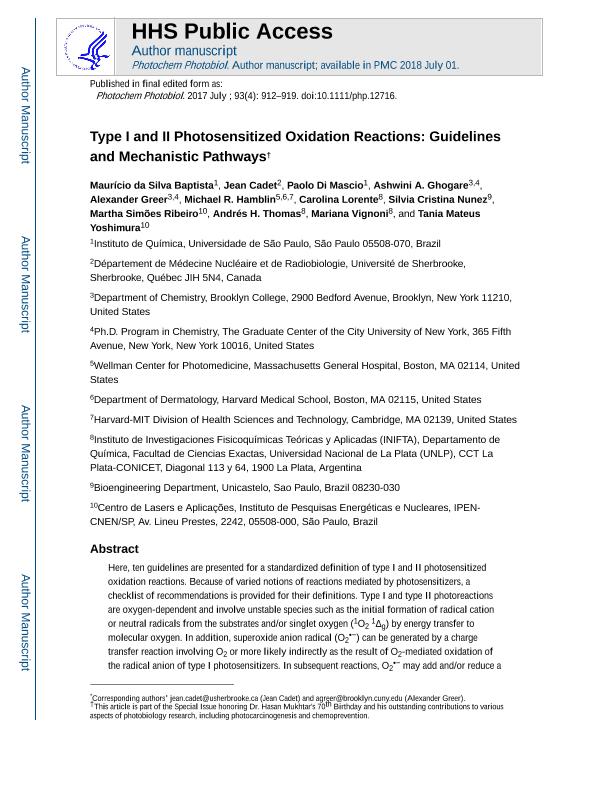Mostrar el registro sencillo del ítem
dc.contributor.author
Baptista, Maurício S.
dc.contributor.author
Cadet, Jean
dc.contributor.author
Di Mascio, Paolo
dc.contributor.author
Ghogare, Ashwini A.
dc.contributor.author
Greer, Alexander
dc.contributor.author
Hamblin, Michael R.
dc.contributor.author
Lorente, Carolina

dc.contributor.author
Nunez, Silvia Cristina
dc.contributor.author
Simoes Ribeiro, Martha

dc.contributor.author
Thomas, Andrés Héctor

dc.contributor.author
Vignoni, Mariana

dc.contributor.author
Yoshimura, Tania Mateus
dc.date.available
2018-11-08T18:33:17Z
dc.date.issued
2017-07
dc.identifier.citation
Baptista, Maurício S.; Cadet, Jean; Di Mascio, Paolo; Ghogare, Ashwini A.; Greer, Alexander; et al.; Type I and Type II Photosensitized Oxidation Reactions: Guidelines and Mechanistic Pathways; Wiley Blackwell Publishing, Inc; Photochemistry and Photobiology; 93; 4; 7-2017; 912-919
dc.identifier.issn
0031-8655
dc.identifier.uri
http://hdl.handle.net/11336/64008
dc.description.abstract
Here, 10 guidelines are presented for a standardized definition of type I and type II photosensitized oxidation reactions. Because of varied notions of reactions mediated by photosensitizers, a checklist of recommendations is provided for their definitions. Type I and type II photoreactions are oxygen-dependent and involve unstable species such as the initial formation of radical cation or neutral radicals from the substrates and/or singlet oxygen (1O2 1∆g) by energy transfer to molecular oxygen. In addition, superoxide anion radical (O.- 2) can be generated by a charge-transfer reaction involving O2 or more likely indirectly as the result of O2-mediated oxidation of the radical anion of type I photosensitizers. In subsequent reactions, O.- 2 may add and/or reduce a few highly oxidizing radicals that arise from the deprotonation of the radical cations of key biological targets.O.- 2 can also undergo dismutation into H2O2, the precursor of the highly reactive hydroxyl radical (.OH) that may induce delayed oxidation reactions in cells. In the second part, several examples of type I and type II photosensitized oxidation reactions are provided to illustrate the complexity and the diversity of the degradation pathways of mostly relevant biomolecules upon one-electron oxidation and singlet oxygen reactions.
dc.format
application/pdf
dc.language.iso
eng
dc.publisher
Wiley Blackwell Publishing, Inc

dc.rights
info:eu-repo/semantics/openAccess
dc.rights.uri
https://creativecommons.org/licenses/by-nc-sa/2.5/ar/
dc.subject
Reactive Oxygen Species
dc.subject
Radicals
dc.subject
Singlet Oxygen
dc.subject
Superoxide Anion
dc.subject.classification
Otras Ciencias Químicas

dc.subject.classification
Ciencias Químicas

dc.subject.classification
CIENCIAS NATURALES Y EXACTAS

dc.title
Type I and Type II Photosensitized Oxidation Reactions: Guidelines and Mechanistic Pathways
dc.type
info:eu-repo/semantics/article
dc.type
info:ar-repo/semantics/artículo
dc.type
info:eu-repo/semantics/publishedVersion
dc.date.updated
2018-10-22T22:31:28Z
dc.journal.volume
93
dc.journal.number
4
dc.journal.pagination
912-919
dc.journal.pais
Reino Unido

dc.journal.ciudad
Londres
dc.description.fil
Fil: Baptista, Maurício S.. Universidade de Sao Paulo; Brasil
dc.description.fil
Fil: Cadet, Jean. University of Sherbrooke; Canadá
dc.description.fil
Fil: Di Mascio, Paolo. Universidade de Sao Paulo; Brasil
dc.description.fil
Fil: Ghogare, Ashwini A.. Brooklyn College; Estados Unidos. City University of New York; Estados Unidos
dc.description.fil
Fil: Greer, Alexander. Brooklyn College; Estados Unidos. City University of New York; Estados Unidos
dc.description.fil
Fil: Hamblin, Michael R.. Massachusetts General Hospital; Estados Unidos. Harvard Medical School; Estados Unidos
dc.description.fil
Fil: Lorente, Carolina. Consejo Nacional de Investigaciones Científicas y Técnicas. Centro Científico Tecnológico Conicet - La Plata. Instituto de Investigaciones Fisicoquímicas Teóricas y Aplicadas. Universidad Nacional de La Plata. Facultad de Ciencias Exactas. Instituto de Investigaciones Fisicoquímicas Teóricas y Aplicadas; Argentina
dc.description.fil
Fil: Nunez, Silvia Cristina. Universidade Camilo Castelo Branco; Brasil
dc.description.fil
Fil: Simoes Ribeiro, Martha. Comissao Nacional de Energia Nuclear. Centro de Lasers e Aplicacoes. Instituto de Pesquisas Energeticas e Nucleares.; Brasil
dc.description.fil
Fil: Thomas, Andrés Héctor. Consejo Nacional de Investigaciones Científicas y Técnicas. Centro Científico Tecnológico Conicet - La Plata. Instituto de Investigaciones Fisicoquímicas Teóricas y Aplicadas. Universidad Nacional de La Plata. Facultad de Ciencias Exactas. Instituto de Investigaciones Fisicoquímicas Teóricas y Aplicadas; Argentina
dc.description.fil
Fil: Vignoni, Mariana. Consejo Nacional de Investigaciones Científicas y Técnicas. Centro Científico Tecnológico Conicet - La Plata. Instituto de Investigaciones Fisicoquímicas Teóricas y Aplicadas. Universidad Nacional de La Plata. Facultad de Ciencias Exactas. Instituto de Investigaciones Fisicoquímicas Teóricas y Aplicadas; Argentina
dc.description.fil
Fil: Yoshimura, Tania Mateus. Comissao Nacional de Energia Nuclear. Centro de Lasers e Aplicacoes. Instituto de Pesquisas Energeticas e Nucleares.; Brasil
dc.journal.title
Photochemistry and Photobiology

dc.relation.alternativeid
info:eu-repo/semantics/altIdentifier/doi/http://dx.doi.org/10.1111/php.12716
dc.relation.alternativeid
info:eu-repo/semantics/altIdentifier/url/https://onlinelibrary.wiley.com/doi/full/10.1111/php.12716
dc.relation.alternativeid
info:eu-repo/semantics/altIdentifier/url/https://www.ncbi.nlm.nih.gov/pmc/articles/PMC5500392/
Archivos asociados
